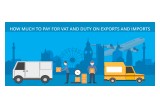
VAT is one of the largest sources of revenue for the United Kingdom Government. It is a tax levied over the consumption of the goods.
London, United Kingdom, April 28, 2017 (Newswire.com) - DNS Accountants shares its insights related to VAT on how it affects businesses and consumers.
What is Value Added Tax?
DNS accounting is one such firm, which acts as a one-stop innovative solution for all the difficult financial problems that serves as a constant burden for you.
Sumit Agarwal, Founder & Managing Partner
VAT is one of the largest sources of revenue for the United Kingdom Government. It is a tax levied over the consumption of the goods. It was firstly introduced in 1973 and is administered under the Value Added Tax Act of 1994. It is collected and managed by HM Revenue and Customs. The guidelines for this tax have been put into the European Union rules as well, which is regulates the minimum value of the tax collected in any of the member countries.
The value of VAT put on any good depends on the rules set up for it by the government. Most of the goods and services produced in the UK as well as some goods produced and imported from other European Union members are eligible to be levied this tax. VAT is an indirect tax, and its value is paid to the government by the seller, while the end consumer pays a similar amount to the seller; this makes the end consumer to be the final payee of the tax.
How does VAT operate in the United Kingdom?
All the sellers and service providers who are making transactions with the consumers and being paid back for the same are eligible to pay VAT. The government has put up a threshold value on the turnover; the threshold being 83,000 Euros. Any establishment with a transaction turnover of more than this threshold is liable to register for the taxation and pay the same to HMRC at the rates set up for their services.
If the turnover is less than the threshold and the businessman wants to register, then they can register on their own will. Interestingly, the threshold value for the tax is the highest here in the UK, throughout the world.
VAT is payable for the whole value of the sold products and services by the registered businesses. They can also avail the facility of ’offset.' This allows the businesses to balance the amount paid by them in VAT while purchasing the goods and services, with the VAT payable by them for the sold items. The general value of VAT is at 20 % for the goods, but it can be reduced (up to zero) through policy decisions.
Flat rate scheme:
A new scheme that states that any business earning less than 1,50,000 Euros can choose to pay a fixed amount of VAT in the period of 3 months. This scheme is meant to reduce the complexity of the taxation modules and also create more inclusive taxation regime. This scheme is increasingly beneficial for the small businesses, which can now get a solution that does not require them to make hefty calculations and go through extensive red tapes.
The amount of VAT payable to HMRC in a quarter if the business is registered for the flat rate scheme, which is the pre-decided percentage of the total sales for the quarter. But when the flat rate scheme is applicable, the business is charged a definite amount every quarter. This reduces the required paperwork and the calculation ordeals by far.
Those registering under this scheme can’t claim VAT exemption on the basis of the expenses on the purchased services and goods. But they can reclaim the VAT that is spent on the purchase of capital assets of worth more than 2,000 Euros.
The basic concept of this scheme is that the registered businesses do not need to keep and provide the account for every transaction made through the quarter to calculate the payable VAT. Instead of this, they can simply pay a preset amount at the flat rate.
This scheme is particularly popular amongst the small and medium sized businesses as it allows them to avail lesser tax rates when compared to the general businesses. HMRC has made it clear that as soon as the registered business starts to cross the threshold of 1,50,000 Euros, it is required to de-register itself from the scheme and start paying Value Added Tax according to the normally levied rates.
Prominent advantages of Flat Rate Scheme:
- Those registered under this scheme can get extra monetary benefits regarding VAT itself. The government is keen at providing these tax benefits as they understand the fact that your participation in this scheme is effectively pulling down their required effort to the minimal.
- One thing that is evident in this scheme is the amount of paperwork, man hours and the effort that is saved because of the ease in calculations of the taxation amount. This benefit is availed at both the taxpayers’ as well as the government’s ends. While HMRC takes VAT online, still there is a lot of extra work that is reduced through Flat Rate Scheme.
- The new businesses are given an extra rebate of 1 % per quarter, if they use this scheme in the first year of operation. This reduces the tax burden on the growing business and improves the chances of expansion.
HMRC Flat VAT rate changes in 2017:
Several changes have been implemented in Flat Rate Scheme from 1 April’17. While earlier there were 54 tax slabs ranging between 4.5 % and 14.5 % according to the sector and the type of service being provided; the new policy wishes to introduce a new slab of 16.5 %. This slab will cater to those businesses which have relatively fewer costs of goods.
These changes are very significant for the industries that are spending lesser in purchasing goods or raw materials; those businesses providing services instead of goods are going to be affected more by these policy changes. The major effect of these policy changes would be seen in the labor extensive industries like IT.
This policy places all the expenses incurred by the business, ranging from employee meals to capital goods, out of the fold of money spent on goods. This means that the money spent under these heads will not be taken into account when deciding the tax factor.
HMRC Flat VAT rate changes 2017 have been introduced because the government has found out that several businesses are using the Flat Rate Scheme to pay taxes that are less than what are expected from them.
The changes in tax rates are policy decisions and are made to suit the needs of the current situations. The current changes in rate are likely to reduce the number of businesses taking this scheme as it tends to put the services industries on the top of the tax slab. The government revenue is expected to rise after the implementation of these changes.
These measures are quite likely to reduce the taxation frauds and also help in regulating the instances of fewer tax payments by the businesses by bending the laws.
Source: DNS Accountants
Share:




